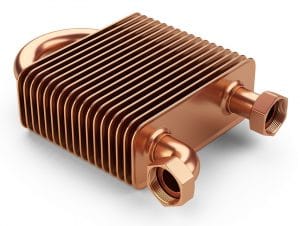 In most industries, companies have traditionally relied on electrical cooling solutions such as air conditioners and air compressors. Such solutions were the most common methods of generating cold air and utilizing it to prevent overheating within an electrical enclosure. However, while these cooling solutions are effective at preventing waste heat from damaging electrical components, they also come with many different considerations that make them less efficient. Today, increasingly more companies are benefiting from the use of more advanced electrical cooling solutions, such as high-performance heat exchangers.
In most industries, companies have traditionally relied on electrical cooling solutions such as air conditioners and air compressors. Such solutions were the most common methods of generating cold air and utilizing it to prevent overheating within an electrical enclosure. However, while these cooling solutions are effective at preventing waste heat from damaging electrical components, they also come with many different considerations that make them less efficient. Today, increasingly more companies are benefiting from the use of more advanced electrical cooling solutions, such as high-performance heat exchangers.
How they prevent electrical overheating
The prevention of electrical overheating is the main goal of any electrical thermal management system. Yet, modern heat exchangers approach the process in a more streamlined and efficient manner than more traditional cooling solutions. For example, rather than generating cold air and circulating it throughout an electrical enclosure’s interior, heat exchangers are designed to use an eco-friendly cooling fluid to rapidly absorb and transfer electrical waste heat. The process of transferring waste heat relies on more natural methods, such as natural/forced convection, conduction, and/or phase-change cooling. Unlike more conventional solutions, these methods can maintain high levels of thermal management with minimal amounts of energy.
The overall costs of operations
When companies implement heat exchangers to cool their electrical enclosures, there are several differences that become immediately noticeable. For example, the reduced need for energy to maintain their electrical cooling systems equates to significantly reduced overall operating costs. In addition, the process of transferring waste heat doesn’t require machinery as complicated or complex as traditional air conditioners and air compressors. Facilitating the flow of the unit’s cooling fluid requires streamlined cooling apparatus, such as cold plates and heat pipes, that don’t consist of external moving parts that can be prone to damage and malfunction. Because of this, companies can also save significantly on the overall costs of maintaining their technologies and electrical cooling systems.
The long-term impacts to production processes
As companies take advantage of more streamlined electrical cooling processes and the reduced costs associated with them, they have more leeway to invest in technologies that further enhance their efficiency and productivity. With the help of more advanced heat exchangers, including custom-designed cooling solutions for unique applications, companies can continue saving as they implement more advanced technological solutions. This has helped boost the advancement of technology and operations in virtually every industry, and increasingly more companies are investing in advanced thermal management solutions to further the disruption.
For more information about what makes heat exchangers different from older cooling solutions, call Noren Thermal Solutions in Taylor, TX, at 866-936-6736.







